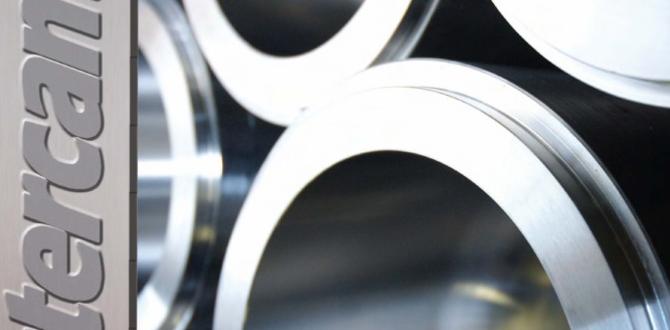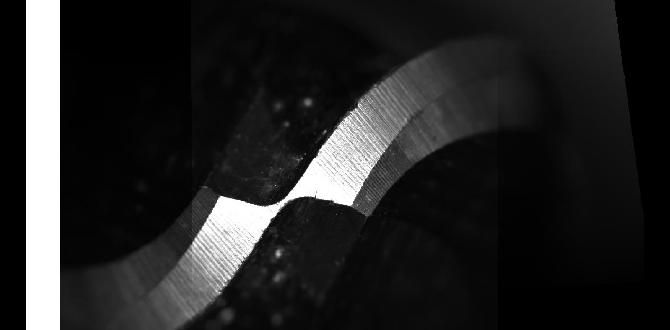Quick Summary:
The Titanium (TiAIN) ball nose end mill with a 35-degree helix angle is an excellent choice for brass milling due to its durability and geometry, allowing for efficient plunge milling and creating smooth radiused features.
Hey there, makers! Daniel Bates here from Lathe Hub. Ever tried to mill intricate shapes in brass and ended up with rough edges or a tool that just didn’t seem to cut cleanly? It’s a common hurdle, especially when you’re just starting out. Brass is a fantastic material to work with, but getting those smooth curves and detailed pockets can feel tricky. The good news is, the right tool makes all the difference. Today, we’re going to dive into a specific hero of the milling world: the 35-degree helix TiAIN coated ball nose end mill. This specialized tool is your secret weapon for tackling brass with confidence. Get ready to unlock cleaner cuts and more precise results for your projects.
Why a 35-Degree TiAIN Ball Nose End Mill for Brass?
You might be wondering, “Why so specific?” It’s a great question! Brass is a relatively soft and gummy metal. When you’re milling it, you want a tool that can handle the material without excessive chip welding or chatter. This is where the 35-degree TiAIN ball nose end mill really shines.
Understanding the Components
Let’s break down what makes this tool so effective for brass Milling:
- Ball Nose Geometry: The rounded tip of the ball nose end mill is perfect for creating radiused corners, concave shapes, and intricate 3D carvings. Unlike flat-bottomed end mills, it can plunge straight down without creating a sharp corner at the bottom of a pocket, which is crucial for smooth transitions.
- 35-Degree Helix Angle: This helix angle is a sweet spot for many materials, including brass. A lower helix angle (compared to, say, 45 or 55 degrees) means the cutting flute makes a shallower angle with the workpiece. For softer metals like brass, this generally results in a smoother cut, less vibration, and better chip evacuation. It’s less aggressive than a high helix angle, which can sometimes lead to tool chatter or material buildup in gummy materials.
- TiAIN Coating: TiAIN (Titanium Aluminum Nitride) is a PVD (Physical Vapor Deposition) coating that’s a step up from basic TiN (Titanium Nitride). It’s known for its excellent hardness, high-temperature resistance, and lubricity. For brass, this coating helps reduce friction, prevent chips from sticking to the tool (welding), and significantly extends the tool’s life, especially when milling at higher speeds or with longer engagement times.
- Material: While the end mill is coated in TiAIN, the base material is typically High-Speed Steel (HSS) or, more commonly for better performance, Solid Carbide. Solid carbide offers superior rigidity, heat resistance, and edge retention compared to HSS, making it the preferred choice for efficient machining.
The combination of these features makes the 35-degree TiAIN ball nose end mill a fantastic choice for anyone looking to achieve precise, clean results when milling brass. It’s particularly well-suited for operations like plunge milling, pocketing, and creating complex surface contours.
When is a 35-Degree TiAIN Ball Nose End Mill Ideal for Brass?
This specific type of end mill isn’t just a general-purpose tool; it excels in certain applications. If your project involves any of the following, this end mill should be high on your list:
- Plunge Milling: This is where the ball nose shines. Plunge milling involves feeding the end mill directly down into the material, often to create pockets or channels. The rounded tip allows for controlled entry without the stress of a sharp corner, and the 35-degree helix helps manage the chip load and heat generated during this aggressive cutting action. This is why the keyword phrase “tialn ball nose end mill 35 degree for brass for plunge milling” is so relevant.
- Creating Radiused Pockets and Features: If your design calls for smooth, rounded internal corners or organic shapes, a ball nose end mill is essential. The 35-degree helix helps maintain a consistent surface finish as you move around these curves.
- 3D Contour Machining: For creating sculpted surfaces or complex 3D models, a ball nose end mill is your primary tool. The 35-degree helix helps in achieving a good surface finish with minimal step-over in your toolpath.
- Detailed Engraving: While specialized engraving tools exist, a smaller diameter ball nose end mill can be used for finer detail work and lettering on brass.
- Achieving a Smooth Surface Finish: The combination of the TiAIN coating and the moderate helix angle contributes to a cleaner cut, reducing the need for extensive post-machining finishing.
In essence, if you’re looking for precision, smooth finishes, and efficient chip management when working with brass, especially in plunge milling or creating curved features, the 35-degree TiAIN ball nose end mill is your go-to tool.
How to Use Your 35-Degree TiAIN Ball Nose End Mill for Brass Milling
Now that you know why this tool is great, let’s talk about how to use it effectively and safely. Milling is all about parameters—speed, feed, depth of cut. Getting these right is key to success and tool longevity.
Essential Setup and Safety Precautions
Before you even think about turning on the spindle, safety and proper setup are paramount. Machining can be dangerous if not approached with respect and caution.
- Wear proper Personal Protective Equipment (PPE): Always wear safety glasses or a full face shield. Hearing protection is also highly recommended. Avoid loose clothing or jewelry that could get caught.
- Secure your workpiece: Ensure the brass is firmly clamped to your milling machine table. Use vises, clamps, or a fixture designed for your machine. Any movement of the workpiece during cutting can lead to tool breakage or dangerous situations.
- Secure the end mill: Make sure the end mill is properly seated and tightened in your collet or tool holder. A loose end mill is a recipe for disaster.
- Clear your work area: Remove any unnecessary tools or materials from the vicinity of the milling machine.
- Know your machine: Understand the controls and capabilities of your milling machine. Ensure emergency stop buttons are accessible.
Step-by-Step Milling Process
Here’s a breakdown of the typical milling process using your 35-degree TiAIN ball nose end mill on brass. We’ll assume you’re using a CNC mill, but the principles apply if you’re using a manual mill with DROs.
- Install the End Mill: Insert the 35-degree TiAIN ball nose end mill into a clean collet and tighten it securely in your milling machine’s spindle.
- Set Up Your Workpiece: Clamp your brass stock firmly to the machine table.
- Program/Set Your Tool Offsets:
- Work Zero (G54, etc.): Establish your program’s origin point on the workpiece.
- Tool Length Offset (G43 Hx): Measure the distance from the spindle face to the tip of the end mill. This tells the machine how far down to move the spindle.
- Tool Diameter Offset (G41/G42 or manual compensation): For ball nose end mills, especially when profiling external or internal radii, you’ll need to tell the machine the tool’s radius or diameter. For plunge milling or pocketing, often you’re using the tool’s actual path, so diameter compensation might not be as critical in the same way as for linear profiling, but it’s good to be aware of.
- Define Cutting Parameters (Speeds and Feeds): This is perhaps the most critical step for machining brass. We’ll cover this in more detail in the next section, but generally, brass likes to be cut relatively fast.
- Set Depth of Cut:
- Plunge Milling: For plunge milling, start with a conservative depth of cut. Around 0.5 to 1 times the tool diameter is a good starting point for many brass alloys. For example, with a 6mm end mill, a depth of cut of 3mm to 6mm down for each plunge pass.
- Contour/Pocketing: For peripheral milling or pocketing, you’ll typically use a shallower axial depth of cut (e.g., 0.1mm to 0.5mm, depending on the tool diameter and desired finish) and a radial depth of cut that’s a percentage of the tool diameter (e.g., 20-50% for a slotting operation).
- Execute the Toolpath:
- For Plunge Milling: The machine will move the tool directly down into the brass from a safe height, then typically perform a helical interpolation or a simple linear plunge to the required depth.
- For Pocketing: The tool path will usually involve a lead-in move, followed by cutting the pocket shape, often in a helical or spiral motion to clear material, and then a lead-out.
- For 3D Contours: The tool will follow the programmed XYZ path, creating the desired surface.
- Chip Evacuation: Throughout the process, keep an eye on chip formation and evacuation. If chips are building up or looking like they are welding to the tool, you may need to adjust your speeds, feeds, or consider using a cutting fluid/lubricant. Compressed air can also be very effective for clearing chips from brass.
- Finishing Pass (Optional): For very smooth surfaces, you might program a final pass at a very shallow depth of cut and potentially a slightly slower feed rate to achieve a polished look.
Speeds and Feeds for Brass Milling
Determining the correct speeds and feeds is crucial. Too slow, and you risk rubbing and poor finish. Too fast, and you risk overheating, chip welding, and tool breakage. Brass is a forgiving material, but getting these parameters right will enhance your results.
The following are general guidelines for solid carbide end mills. Always start conservatively and listen to your machine and observe the chips.
Key Terms:
- Spindle Speed (RPM): How fast the tool rotates.
- Feed Rate (IPM or mm/min): How fast the tool moves through the material.
- Surface Speed (SFM or m/min): The speed of the cutting edge relative to the material. This is what manufacturers often specify for their tools and coatings.
- Chip Load (CL): The thickness of the chip being removed by each cutting edge.
General Recommendations for Brass (Solid Carbide End Mill):
A good starting point for surface speed for solid carbide end mills in brass is around 300-600 SFM (90-180 m/min). The TiAIN coating will help achieve higher speeds due to its hardness and reduced friction.
Calculation Example (using Surface Speed):
Let’s say you have a 6mm diameter end mill and want to run at 400 SFM.
First, convert SFM to SMM (Surface Meters per Minute): 400 SFM 0.3048 m/ft = 121.92 m/min.
Now, calculate Spindle Speed (RPM):
RPM = (Surface Speed in m/min 1000) / (Tool Diameter in mm π)
RPM = (121.92 1000) / (6 3.14159) ≈ 6458 RPM
Feed Rate Calculation:
A typical chip load for brass with a solid carbide end mill can range from 0.0005 to 0.002 inches per tooth (0.013 to 0.05 mm per tooth). This depends heavily on the tool diameter and the number of flutes.
Feed Rate (IPM) = Spindle Speed (RPM) Chip Load (inches/tooth) Number of Flutes
Assuming a 2-flute end mill and a chip load of 0.001 inches/tooth:
Feed Rate = 6458 RPM 0.001 in/tooth 2 flutes ≈ 12.9 IPM
In metric (mm/min):
Feed Rate (mm/min) = Spindle Speed (RPM) Chip Load (mm/tooth) Number of Flutes
Assuming a 2-flute end mill and a chip load of 0.025 mm/tooth:
Feed Rate = 6458 RPM 0.025 mm/tooth * 2 flutes ≈ 323 mm/min
Important Notes on Speeds and Feeds:
- Tool Diameter: Smaller diameter tools require higher RPMs and generally lower feed rates and chip loads. Larger diameter tools run slower RPMs but higher feed rates.
- Number of Flutes: End mills with more flutes (e.g., 4) are generally used for finishing and are less suitable for plunging or slotting where chip evacuation is critical. For plunge milling or heavy material removal, 2 or 3-flute tools are often preferred.
- Depth of Cut: A shallower axial depth of cut allows for a higher feed rate. With plunge milling, you are essentially using the full diameter as your axial depth of cut, which requires careful management of chip load and feed rate.
- Machine Rigidity: A more rigid machine can handle higher cutting forces, allowing for more aggressive parameters.
- Lubrication: Using a cutting fluid or mist can significantly improve performance by cooling the tool and workpiece, lubricating the cut, and helping to evacuate chips. This is particularly beneficial with TiAIN coated tools.
- Brass Alloy: Different brass alloys (e.g., free-machining brass like C36000) have varying machinability. Free-machining brass is designed for easy cutting and can often handle higher speeds and feeds.
Many modern CAM software packages have built-in calculators that can suggest starting speeds and feeds based on tool type, material, and desired finish. Online calculators are also a great resource. For the most authoritative guidance, consult the end mill manufacturer’s specifications. For example, a reputable manufacturer like Harvey Tool provides excellent resources and calculators for their cutting tools.
Choosing the Right Diameter and Flute Count
When selecting your 35-degree TiAIN ball nose end mill, the diameter and number of flutes are key considerations for brass milling.
Diameter Selection
The diameter of your end mill will be dictated by the task at hand:
- For general pocketing and contouring: A common choice is between 6mm and 12mm (or 1/4″ to 1/2″). These sizes offer a good balance between material removal rate and the ability to create fine details.
- For intricate details, engraving, or small radii: Smaller diameters such as 1mm, 2mm, or 3mm (or 1/16″ to 1/8″) are necessary. Be aware that smaller tools are more fragile and require lighter cuts and higher spindle speeds.
- For larger, shallower features or faster roughing: Larger diameters, like 16mm or 20mm (or 5/8″ to 3/4″), can be used, but they demand a more robust machine and will require significantly lower spindle speeds.
Always consider the smallest radius you need to machine. The radius of your ball nose end mill must be equal to or smaller than the internal radius you want to create. For example, to create a 5mm internal radius, you’ll need at least a 5mm radius ball nose end mill (which is a 10mm diameter ball nose end mill).
Flute Count Considerations
The number of flutes on an end mill affects its chip-clearing capabilities and its suitability for different operations:
- 2 Flutes: Often preferred for plunging operations and slotting (making full-width cuts). The larger flute gullets (the space between the flutes) provide excellent chip evacuation, which is crucial for gummy materials like brass to prevent chip welding and tool breakage. They also provide good rigidity for challenging cuts.
- 3 Flutes: A good option for general-purpose milling, including pocketing and contouring. They offer a good balance between chip clearance and stability compared to 4-flute tools.
- 4 Flutes: Generally used for finishing passes or







